TOYOTA GT86 2016 Owners Manual (in English)
Manufacturer: TOYOTA, Model Year: 2016, Model line: GT86, Model: TOYOTA GT86 2016Pages: 464, PDF Size: 17.53 MB
Page 321 of 464
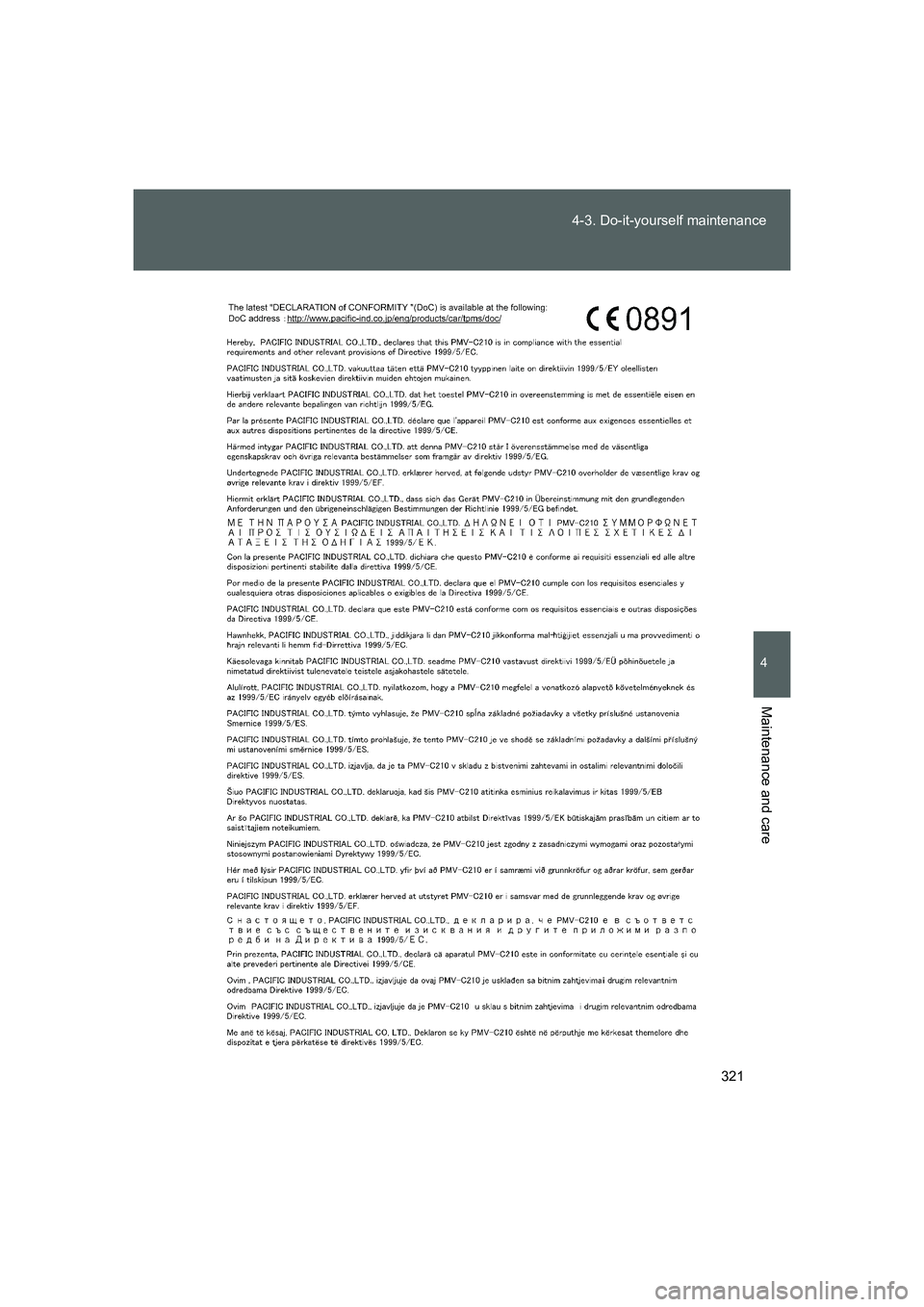
321 4-3. Do-it-yourself maintenance
4
Maintenance and care
FT86_EE
86_OM_EE_OM18058E.book 321 ページ 2015年3月17日 火曜日 午前11時31分
Page 322 of 464
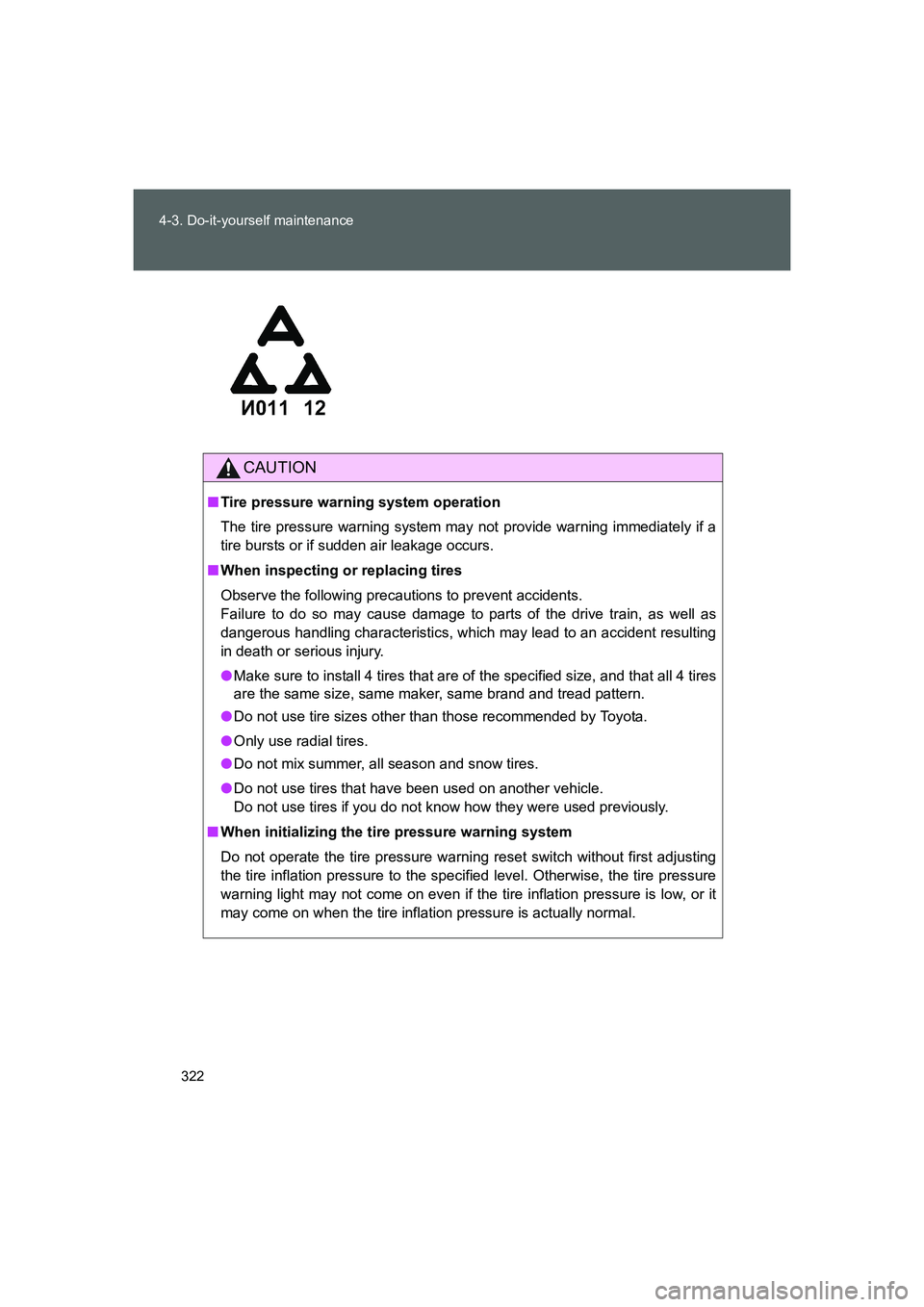
322 4-3. Do-it-yourself maintenance
FT86_EE
CAUTION
■Tire pressure warning system operation
The tire pressure warning system may not provide warning immediately if a
tire bursts or if sudden air leakage occurs.
■When inspecting or replacing tires
Observe the following precautions to prevent accidents.
Failure to do so may cause damage to parts of the drive train, as well as
dangerous handling characteristics, which may lead to an accident resulting
in death or serious injury.
●Make sure to install 4 tires that are of the specified size, and that all 4 tires
are the same size, same maker, same brand and tread pattern.
●Do not use tire sizes other than those recommended by Toyota.
●Only use radial tires.
●Do not mix summer, all season and snow tires.
●Do not use tires that have been used on another vehicle.
Do not use tires if you do not know how they were used previously.
■When initializing the tire pressure warning system
Do not operate the tire pressure warning reset switch without first adjusting
the tire inflation pressure to the specified level. Otherwise, the tire pressure
warning light may not come on even if the tire inflation pressure is low, or it
may come on when the tire inflation pressure is actually normal.
86_OM_EE_OM18058E.book 322 ページ 2015年3月17日 火曜日 午前11時31分
Page 323 of 464
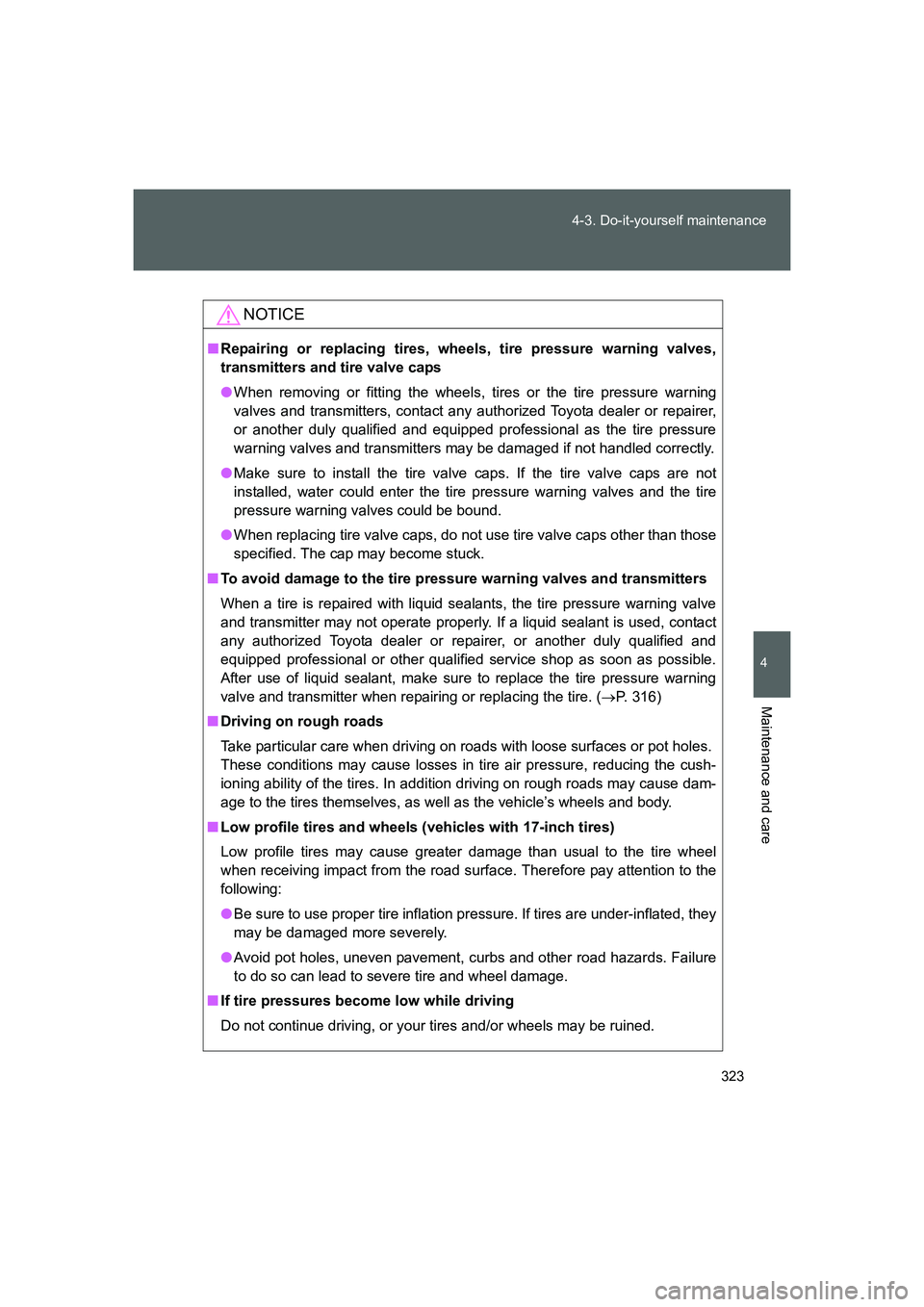
323 4-3. Do-it-yourself maintenance
4
Maintenance and care
FT86_EE
NOTICE
■Repairing or replacing tires, wheels, tire pressure warning valves,
transmitters and tire valve caps
●When removing or fitting the wheels, tires or the tire pressure warning
valves and transmitters, contact any authorized Toyota dealer or repairer,
or another duly qualified and equipped professional as the tire pressure
warning valves and transmitters may be damaged if not handled correctly.
●Make sure to install the tire valve caps. If the tire valve caps are not
installed, water could enter the tire pressure warning valves and the tire
pressure warning valves could be bound.
●When replacing tire valve caps, do not use tire valve caps other than those
specified. The cap may become stuck.
■To avoid damage to the tire pressure warning valves and transmitters
When a tire is repaired with liquid sealants, the tire pressure warning valve
and transmitter may not operate properly. If a liquid sealant is used, contact
any authorized Toyota dealer or repairer, or another duly qualified and
equipped professional or other qualified service shop as soon as possible.
After use of liquid sealant, make sure to replace the tire pressure warning
valve and transmitter when repairing or replacing the tire. (→P. 316)
■Driving on rough roads
Take particular care when driving on roads with loose surfaces or pot holes.
These conditions may cause losses in tire air pressure, reducing the cush-
ioning ability of the tires. In addition driving on rough roads may cause dam-
age to the tires themselves, as well as the vehicle’s wheels and body.
■Low profile tires and wheels (vehicles with 17-inch tires)
Low profile tires may cause greater damage than usual to the tire wheel
when receiving impact from the road surface. Therefore pay attention to the
following:
●Be sure to use proper tire inflation pressure. If tires are under-inflated, they
may be damaged more severely.
●Avoid pot holes, uneven pavement, curbs and other road hazards. Failure
to do so can lead to severe tire and wheel damage.
■If tire pressures become low while driving
Do not continue driving, or your tires and/or wheels may be ruined.
86_OM_EE_OM18058E.book 323 ページ 2015年3月17日 火曜日 午前11時31分
Page 324 of 464
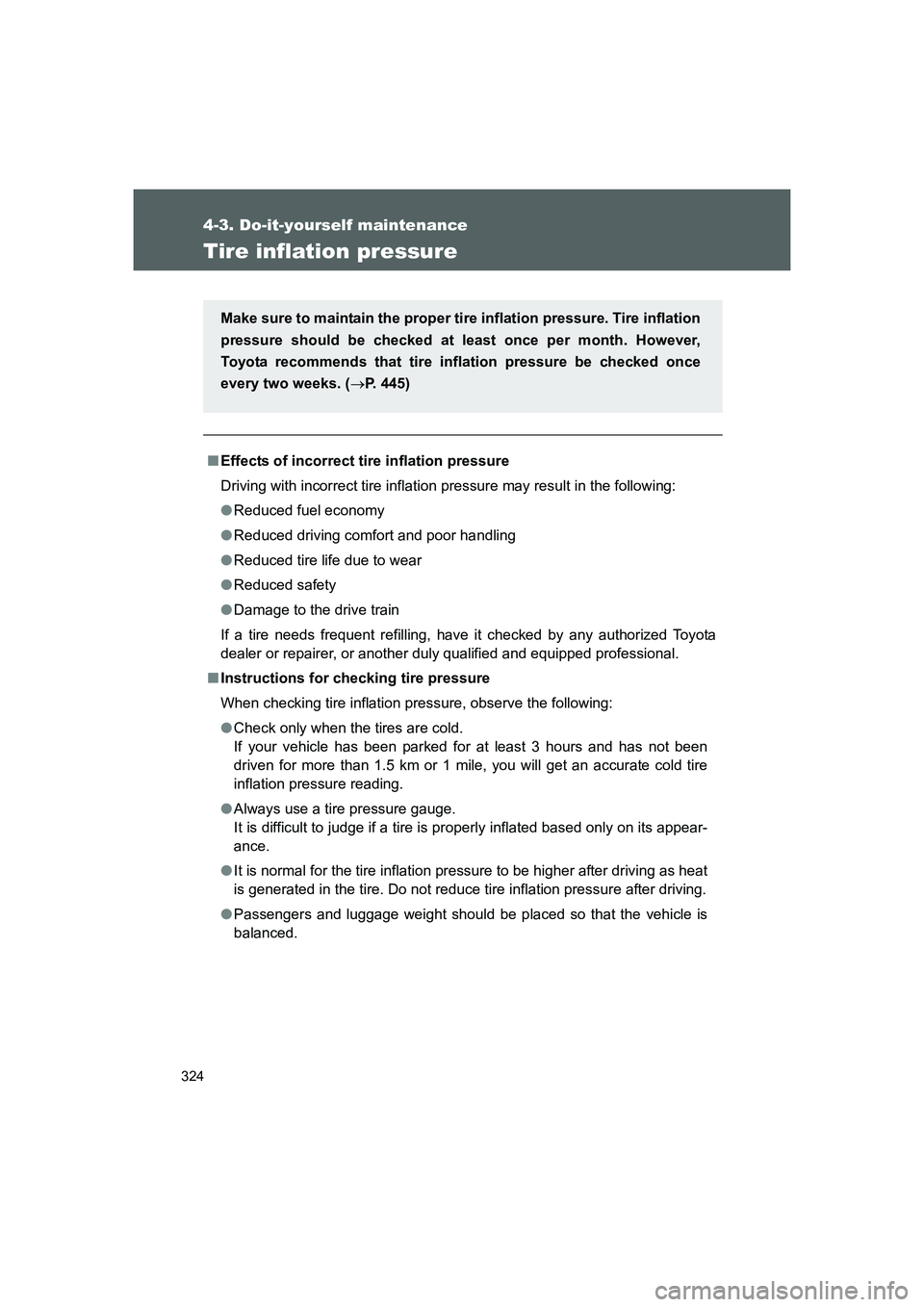
324
4-3. Do-it-yourself maintenance
FT86_EE
Tire inflation pressure
■Effects of incorrect tire inflation pressure
Driving with incorrect tire inflation pressure may result in the following:
●Reduced fuel economy
●Reduced driving comfort and poor handling
●Reduced tire life due to wear
●Reduced safety
●Damage to the drive train
If a tire needs frequent refilling, have it checked by any authorized Toyota
dealer or repairer, or another duly qualified and equipped professional.
■Instructions for checking tire pressure
When checking tire inflation pressure, observe the following:
●Check only when the tires are cold.
If your vehicle has been parked for at least 3 hours and has not been
driven for more than 1.5 km or 1 mile, you will get an accurate cold tire
inflation pressure reading.
●Always use a tire pressure gauge.
It is difficult to judge if a tire is properly inflated based only on its appear-
ance.
●It is normal for the tire inflation pressure to be higher after driving as heat
is generated in the tire. Do not reduce tire inflation pressure after driving.
●Passengers and luggage weight should be placed so that the vehicle is
balanced. Make sure to maintain the proper tire inflation pressure. Tire inflation
pressure should be checked at least once per month. However,
Toyota recommends that tire inflation pressure be checked once
every two weeks. (→P. 445)
86_OM_EE_OM18058E.book 324 ページ 2015年3月17日 火曜日 午前11時31分
Page 325 of 464

325 4-3. Do-it-yourself maintenance
4
Maintenance and care
FT86_EE
CAUTION
■Proper inflation is critical to save tire performance
Keep your tires properly inflated.
If the tires are not properly inflated, the following conditions may occur which
could lead to an accident resulting in death or serious injury:
●Excessive wear
●Uneven wear
●Poor handling
●Possibility of blowouts resulting from overheated tires
●Air leaking from between tire and wheel
●Wheel deformation and/or tire damage
●Greater possibility of tire damage while driving (due to road hazards,
expansion joints, sharp edges in the road, etc.)
NOTICE
■When inspecting and adjusting tire pressure
Be sure to reinstall the tire valve caps.
If a valve cap is not installed, dirt or moisture may get into the valve and
cause an air leak, resulting in decreased tire inflation pressure.
86_OM_EE_OM18058E.book 325 ページ 2015年3月17日 火曜日 午前11時31分
Page 326 of 464
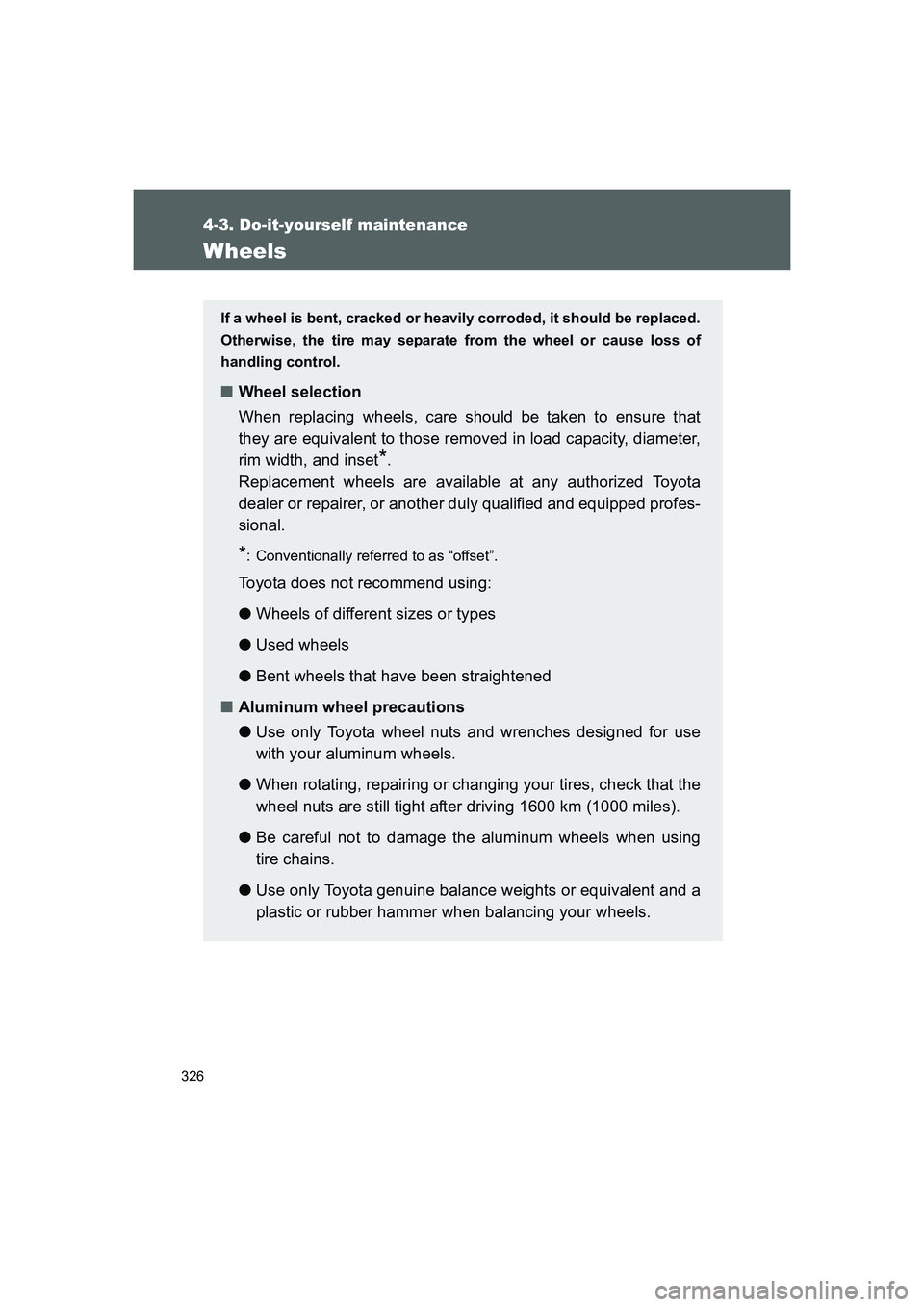
326
4-3. Do-it-yourself maintenance
FT86_EE
Wheels
If a wheel is bent, cracked or heavily corroded, it should be replaced.
Otherwise, the tire may separate from the wheel or cause loss of
handling control.
■Wheel selection
When replacing wheels, care should be taken to ensure that
they are equivalent to those removed in load capacity, diameter,
rim width, and inset
*.
Replacement wheels are available at any authorized Toyota
dealer or repairer, or another duly qualified and equipped profes-
sional.
*: Conventionally referred to as “offset”.
Toyota does not recommend using:
●Wheels of different sizes or types
●Used wheels
●Bent wheels that have been straightened
■Aluminum wheel precautions
●Use only Toyota wheel nuts and wrenches designed for use
with your aluminum wheels.
●When rotating, repairing or changing your tires, check that the
wheel nuts are still tight after driving 1600 km (1000 miles).
●Be careful not to damage the aluminum wheels when using
tire chains.
●Use only Toyota genuine balance weights or equivalent and a
plastic or rubber hammer when balancing your wheels.
86_OM_EE_OM18058E.book 326 ページ 2015年3月17日 火曜日 午前11時31分
Page 327 of 464
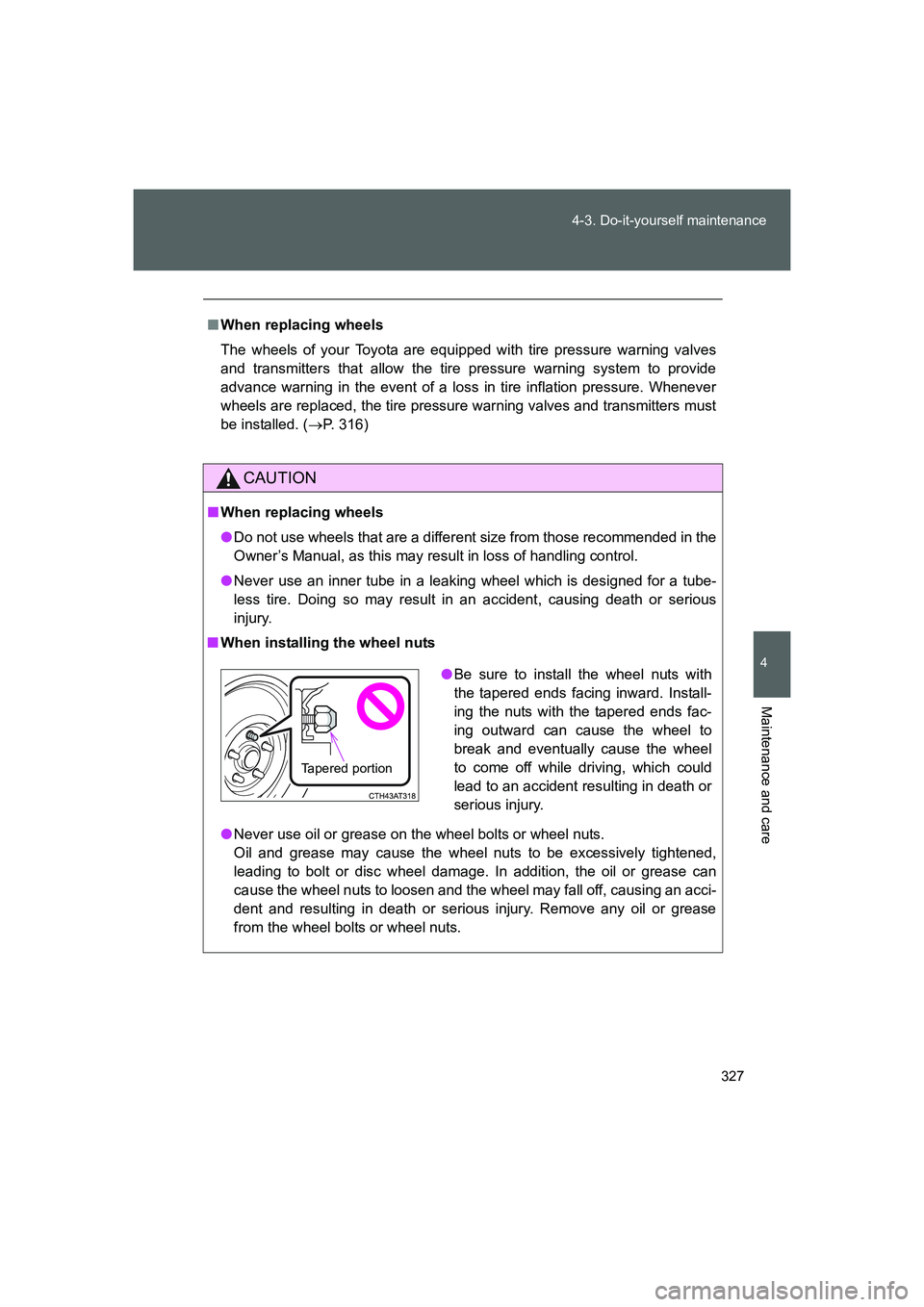
327 4-3. Do-it-yourself maintenance
4
Maintenance and care
FT86_EE
■When replacing wheels
The wheels of your Toyota are equipped with tire pressure warning valves
and transmitters that allow the tire pressure warning system to provide
advance warning in the event of a loss in tire inflation pressure. Whenever
wheels are replaced, the tire pressure warning valves and transmitters must
be installed. (→P. 316)
CAUTION
■When replacing wheels
●Do not use wheels that are a different size from those recommended in the
Owner’s Manual, as this may result in loss of handling control.
●Never use an inner tube in a leaking wheel which is designed for a tube-
less tire. Doing so may result in an accident, causing death or serious
injury.
■When installing the wheel nuts
●Never use oil or grease on the wheel bolts or wheel nuts.
Oil and grease may cause the wheel nuts to be excessively tightened,
leading to bolt or disc wheel damage. In addition, the oil or grease can
cause the wheel nuts to loosen and the wheel may fall off, causing an acci-
dent and resulting in death or serious injury. Remove any oil or grease
from the wheel bolts or wheel nuts.
●Be sure to install the wheel nuts with
the tapered ends facing inward. Install-
ing the nuts with the tapered ends fac-
ing outward can cause the wheel to
break and eventually cause the wheel
to come off while driving, which could
lead to an accident resulting in death or
serious injury.
Tapered portion
86_OM_EE_OM18058E.book 327 ページ 2015年3月17日 火曜日 午前11時31分
Page 328 of 464
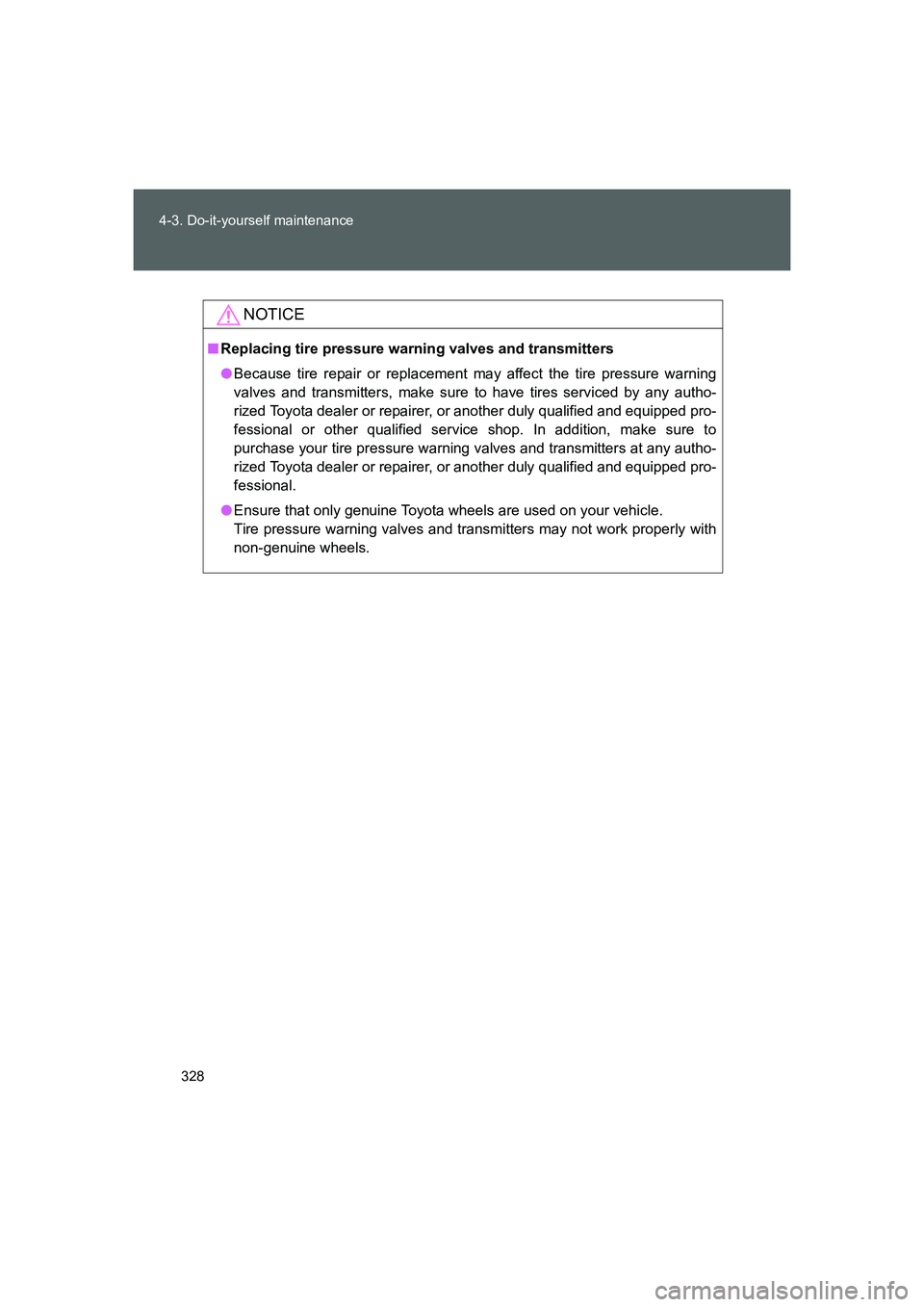
328 4-3. Do-it-yourself maintenance
FT86_EE
NOTICE
■Replacing tire pressure warning valves and transmitters
●Because tire repair or replacement may affect the tire pressure warning
valves and transmitters, make sure to have tires serviced by any autho-
rized Toyota dealer or repairer, or another duly qualified and equipped pro-
fessional or other qualified service shop. In addition, make sure to
purchase your tire pressure warning valves and transmitters at any autho-
rized Toyota dealer or repairer, or another duly qualified and equipped pro-
fessional.
●Ensure that only genuine Toyota wheels are used on your vehicle.
Tire pressure warning valves and transmitters may not work properly with
non-genuine wheels.
86_OM_EE_OM18058E.book 328 ページ 2015年3月17日 火曜日 午前11時31分
Page 329 of 464
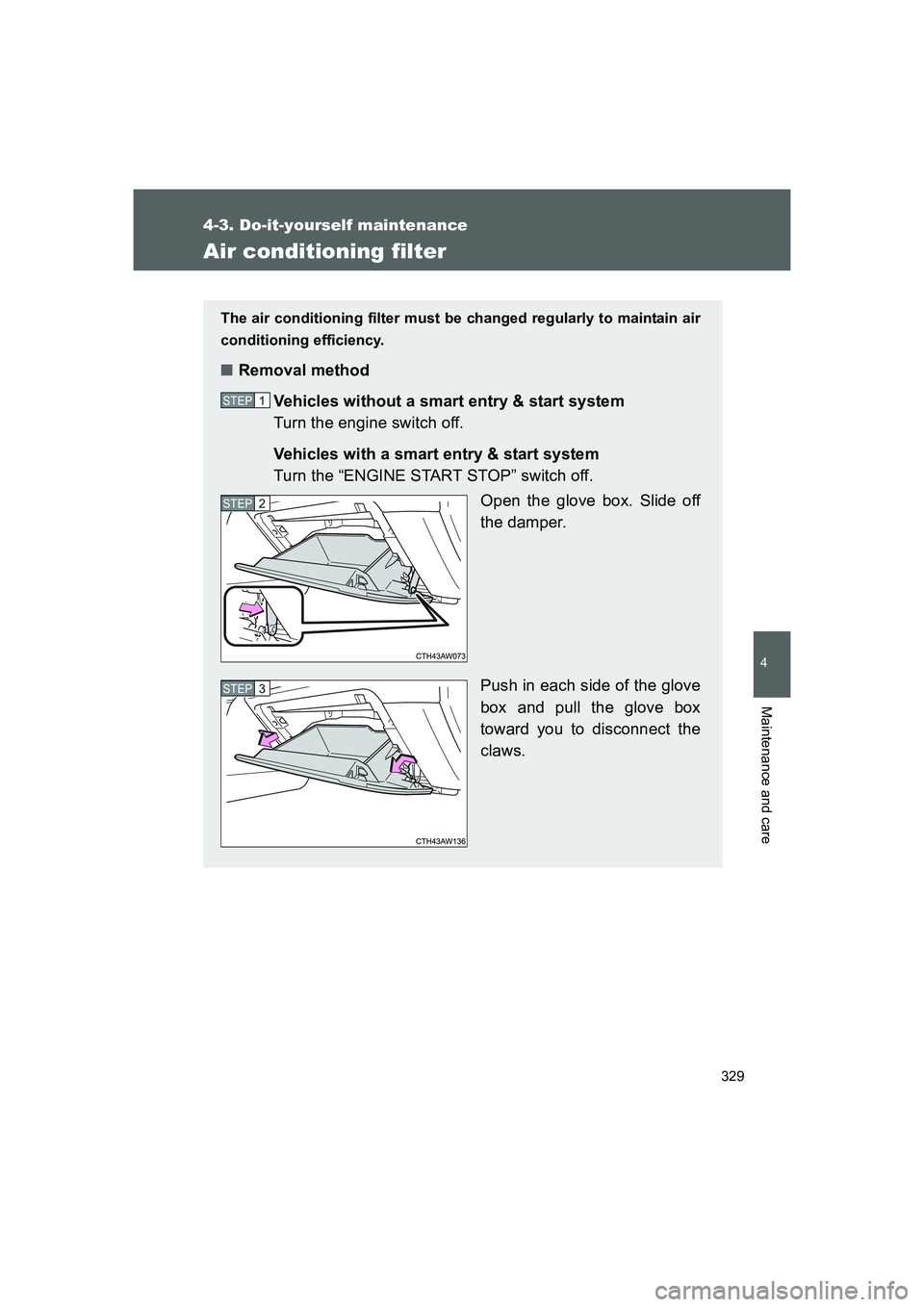
329
4-3. Do-it-yourself maintenance
4
Maintenance and care
FT86_EE
Air conditioning filter
The air conditioning filter must be changed regularly to maintain air
conditioning efficiency.
■Removal method
Vehicles without a smart entry & start system
Turn the engine switch off.
Vehicles with a smart entry & start system
Turn the “ENGINE START STOP” switch off.
Open the glove box. Slide off
the damper.
Push in each side of the glove
box and pull the glove box
toward you to disconnect the
claws.
STEP 1
STEP 2
STEP 3
86_OM_EE_OM18058E.book 329 ページ 2015年3月17日 火曜日 午前11時31分
Page 330 of 464
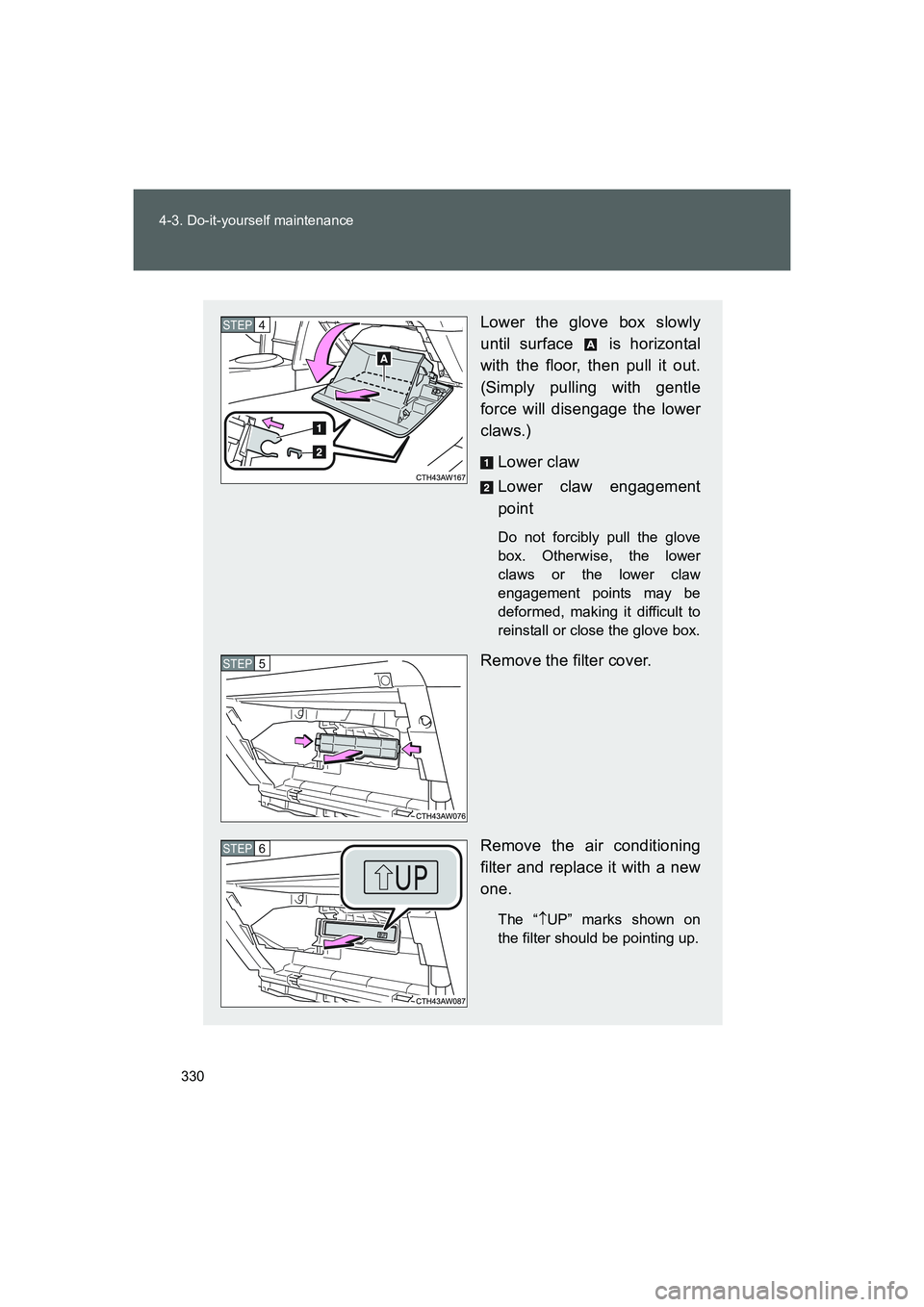
330 4-3. Do-it-yourself maintenance
FT86_EE
Lower the glove box slowly
until surface is horizontal
with the floor, then pull it out.
(Simply pulling with gentle
force will disengage the lower
claws.)
Lower claw
Lower claw engagement
point
Do not forcibly pull the glove
box. Otherwise, the lower
claws or the lower claw
engagement points may be
deformed, making it difficult to
reinstall or close the glove box.
Remove the filter cover.
Remove the air conditioning
filter and replace it with a new
one.
The “↑UP” marks shown on
the filter should be pointing up.
STEP 4
STEP 5
STEP 6
86_OM_EE_OM18058E.book 330 ページ 2015年3月17日 火曜日 午前11時31分